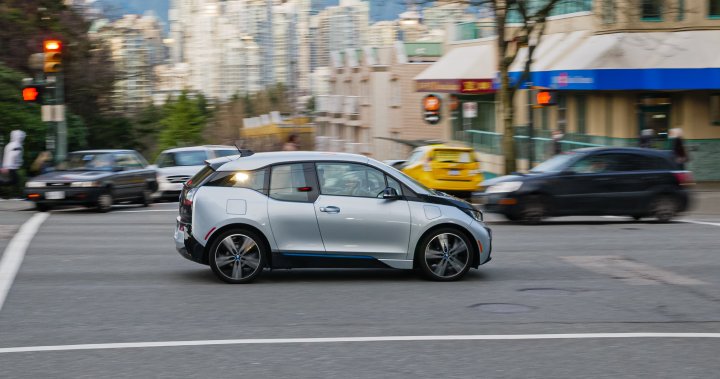My neighbourhood is lousy with electric vehicles: all flavours of Teslas, scattered Volts and Bolts, a selection of Hyundais and KIAs, a couple of Nissan Leafs (Leaves?) along with some Taycans, at two Polestars that I’ve seen, and at least one Lucid. They’re all loaded with so much fabulous spaceship tech that the mind boggles at what our driving experiences will be in the next 10 years.
However, one piece of tech is missing from many of them: a good old-fashioned AM radio, a feature that goes back almost a hundred years.
As far as people can tell, Kelley’s Motors in New South Wales, Australia, was the first to jam a new-fangled aftermarket radio into a car back in 1924. But it was the Galvin brothers and their new company, Motorola, that created the ancestor of all car infotainment units when they fitted a six vacuum-tube AM radio in a Ford Model A in June 1930. They overcame plenty of engineering problems, including where to put the giant high-voltage batteries (under the passenger seat), how to house the six vacuum tubes (in a big wooden case), placement of the antenna (on the roof), and most importantly, how to eliminate static caused by the electrical activity of the engine.
AM signals are easily disrupted by electrical activity. Overhead powerlines, lightning, external electric motors, and even the running of an automobile engine are enough to cause crashing static, buzzing, and fade-outs. The Galvins’ solution was to fit the spark plugs of their Model A with a “suppressor” so that the firing sequence of the cylinders no longer interfered with the radio. Tuning the engine down like this actually hurt performance, but at least motorists got to listen to programming that was relatively static-free.
Eventually, the Galvins figured out other ways around the static problem, and suppressors were eliminated. But environmental electrical interference remained, and this spurred the development of static-free FM radio. (That’s another story entirely.)

Ninety years later, the AM static problem is back. And it’s bad.
Today’s electric vehicles are powered by motors that generate electromagnetic fields that happen to operate in the same frequencies as AM radio signals. The result is a war between these wavelengths. The more powerful these motors get, the more adept they are at cancelling out AM signals. It’s can make for annoying listening. Other bits of tech, including speed controllers and some of the other electron-power magic inside these cars, also cause havoc with frequencies between 530 and 1700 kHz, which is where AM radio lives.
While there are EVs that offer AM radio as part of their infotainment systems, owners are warned upfront by the manufacturer about the same kind of static, buzzing, distortion, and fade-out issues the Galvin brothers struggled with back in 1930.
Thanks to the physical properties of the FM band, those stations are unaffected by the electromagnetic fields generated by their vehicles. So is satellite radio. What can be done about AM radio then?
Some manufacturers are eliminating AM radio altogether. BMW first identified the AM reception problem as a quality issue in 2009. By 2014, there was no AM radio to be found in their i3 EV. Tesla started dumping all AM radio options in 2018 and all models are now AM-free. Want to listen to the hockey game on your local AM station? Not if you’re driving a Tesla. In fact, Tesla continues to lean away from over-the-air broadcasting, moving more in the direction of streaming options.
And BMW and Tesla aren’t the only OEMs dumping the AM band. Porsche’s all-electric Taycan doesn’t list an AM radio on its standard equipment list. Audi’s e-Trons don’t have AM. Mercedes-Benz’s all-electric EQS flagship? Nope. Volvo’s XC40 and C40 Recharge? Too much interference, so the AM radio was left out.
Meanwhile, manufacturers are discovering that a not-insignificant number of customers are annoyed when they realize they can’t listen to the ball game, talk shows, or news stations as they drive. Canada, for example, has 99 per cent of its news, talk, and sports stations on AM stations. If you commute, you may rely on AM radio for traffic and weather reports. For this reason, Ford has decided to keep AM radio in its Mustang Mach-E and the F-150 Lightning pickup. General Motors and Stellantis also offer EVs with AM radios.
Across the ocean, AM radio has long been in decline in Europe as the continent moves to DAB — something that will never happen here — so it’s no surprise that European-made vehicles were the first to eliminate AM units. France, the Netherlands, Norway, and Russia, are just some of the countries getting rid of AM entirely. Meanwhile, 95 per cent of new cars sold in places like Germany and the United Kingdom come standard with DAB+ receivers. Their infotainment systems are very different from ours.
Back on our side of the Atlantic, consider the wide-open spaces in North America. AM signals travel much further than FM. If you’re in the middle of nowhere in an AM-less EV and you don’t have a satellite radio subscription, you could be faced with listening to nothing at all. Not good.
But the static problems remain. And as EVs become more popular, owners of AM stations are concerned. In-car listening is their bread-and-butter.
The question is whether manufacturers are willing to throw money and engineers at the problem. The EV issue is far more complicated than the spark problem faced by the Galvin brothers. Some simple solutions have been implemented, like additional shielding on vital cabling and wires. That, however, is often thwarted by the hundreds of watts EVs draw from their batteries. Tesla searches for AM stations that simulcast their signal on HD. It’s a workaround, but it helps. Another solution might come with the widespread introduction of 5G connectivity. AM signals could also be delivered that way.
When asked for his opinion on the most beautiful sounds in the world, Tom Waits replied “A baseball game on summer’s evening heard through an AM radio.” He’s not wrong. I’d hate for those sounds to go away.
—
Alan Cross is a broadcaster with Q107 and 102.1 the Edge and a commentator for Global News.
Subscribe to Alan’s Ongoing History of New Music Podcast now on Apple Podcast or Google Play
© 2022 Global News, a division of Corus Entertainment Inc.



